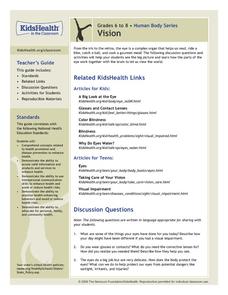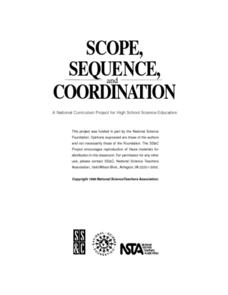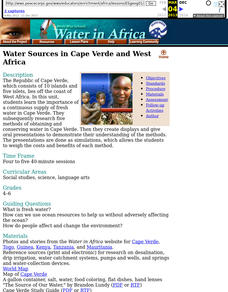CK-12 Foundation
Contact Lens
How do contact lenses work? The simulation allows young scientists to explore focal length and lens type to see how and why contact lenses work. Pupils control the focal length for an eye and a lens, the type of lens, and the distance...
Exploratorium
Cardboard Tube Syllabus
Construct paper tubes and then try out a few optical illusion tricks:
See a virtual hole in your own hand
Get a grasp of how the eyes combine images
Notice that one eye is dominant over the other
Reveal how your eyes adjust to...
Exploratorium
Pupil
Give pupils a magnifier, a mirror, and a flashlight so that they can examine their own pupils. As they shine a light on their eyes, the light is shone on how this structure dilates and contracts to control how much is allowed into the...
Curated OER
Biomedical Devices for the Eyes
Students study the structures of the human eye. In this eye device lesson students examine different eye problems and devices that can help to resolve them.
Curated OER
Technology and the Human Eye
Fifth graders compare technology and the human eye. In this science instructional activity, 5th graders label the parts of the human eye and trace the path of light as it travels through the eye.
Nemours KidsHealth
Vision
From the iris and retina to glasses and contact lenses, learners will be excited to see what activities are in store for them as they learn about the complex organ of the human eye.
Messenger Education
Snow Goggles and Limiting Sunlight
Why would someone need contact lenses that offer UV protection? With a 28-page packet full of instruction and worksheets, learners discuss solar radiation and its potential harm to eyes. They make snow goggles similar...
Curated OER
Eye Safety
Tenth graders become aware of the need for eye safety in the classroom through three mini labs.
Curated OER
Animal Behavior
Can you train a worm? Biology buffs will have a blast trying! Using planaria or earthworms, they introduce a certain stimulus repeatedly until the desired response happens more quickly. They also explore the response of their own eyes to...
Curated OER
Variation and Heredity
Junior geneticists tally eye color and height in their lab groups. They examine certain traits in soybean and corn seedlings. For each activity, they gather data and learn about continuous and discontinuous genetic variation. In another...
Curated OER
Motion and Inertia
Physics learners make magic with inertia! By pulling paper out from under a stack of blocks or batting a rubber ball into motion, physics scholars' eyes will be opened! Don't think that this lesson is only fun and games; plenty of...
Curated OER
Qualitative Aspects of Rotational Dynamics
Explanations for six different physics lab activities and five suggested assessments are contained in this resource by the National Science Teachers Association. Any combination can be used to open learners' eyes to rotational motion....
Cornell Lab of Ornithology
Investigating Evidence
Explore the scientific process through nature. Scholars become scientists as they develop a question, design an experiment, collect data, and analyze their results. A two-week lesson guides your classes through the process and provides...
Curated OER
How We See
Learners study how images they see are transmitted to the brain. In this sight lesson students complete several activities that have to do with visual pathways and field defects.
Curated OER
Keep Your Eye on the Sky
Students examine the different types of satellites, cloud formations and weather patterns. In this weather lesson students use the Internet to research weather satellites, then write an article and create graphs.
Curated OER
Trout Cookies
Students explore the external anatomy of a fish. In this anatomy and adaptations instructional activity, students look at an image of a trout and identify its various external features including fins, eyes, spots, parr marks and lateral...
Curated OER
Looking At Acid's Effects On Metals
Students perform an experiment that demonstrates acid rain. The chemical effect of acids on metals may take at least five days for the human eye to see, even though the reaction starts as soon as the acid contacts the metal.
Curated OER
Glasses
In this glasses activity, students answer multiple choice questions about the science behind the eye and how glasses work. Students answer 4 questions.
Curated OER
Coefficient of Kinetic Friction and Surface Area
Young scholars investigate coefficient of friction with respect to surface area and applied force in contact with the sliding force.
Curated OER
Water Sources in Cape Verde and West Africa
Young explorers study the scarcity and importance of a continuous supply of fresh water in Cape Verde. They research the five main ways that fresh water is obtained in these countries. Each research group prepares a presentation, and...
Curated OER
Exploring a Teaching Career Through an Energy Lesson
After learning how to dentify information on energy and its conservation. your class can work in groups to create an activity and lesson plan for elementary high schoolers, teaching all about energy and its conservation. Students...
American Chemical Society
Exothermic, Endothermic, and Chemical Change
Scientists can't observe bonds breaking or forming, so how do they distinguish between exothermic and endothermic reactions? Young scholars complete two experiments to do just that. They monitor temperature change and calculate the...
Channel Islands Film
Santa Cruz Island Restoration Narrative
What would you be willing to do to save an animal from extinction? After re-viewing a video about the restoration of the Island Fox on Santa Cruz Island, individuals adopt the point of view of one of the key players in the...
Curated OER
Exploring a Teaching Career Through an Energy Lesson
Students design their own energy conservation lesson plan to teach elementary school students. They use this lesson plan to determine if they would like to pursue a teaching career
Other popular searches
- Eye Contact Activities
- Making Eye Contact
- Public Speaking Eye Contact
- Social Skills Eye Contact
- Friendship Eye Contact
- Matain Eye Contact
- Autism Maintain Eye Contact
- Autism Maintaing Eye Contact
- Eye Contact Lessons
- Martainn Eye Contact
- Learning Eye Contact
- Maintain Eye Contact























